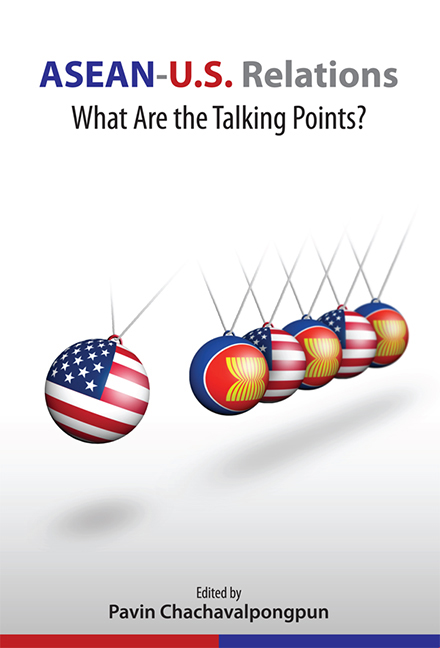Book contents
- Frontmatter
- Contents
- List of Tables and Figures
- Preface
- Contributors
- List of Abbreviations
- OVERVIEW
- QUINTESSENTIAL ISSUES
- 6 A New Era in the Long-Standing U.S.-ASEAN Relationship
- 7 Maritime Security in Southeast Asia and the United States
- 8 ASEAN's View on the U.S. Military Role in the Region
- 9 United States–China Relations
- 10 Shift in U.S. Policy towards Myanmar
- 11 United States Assistance to ASEAN through the ADVANCE Programme
- 12 Conclusion
- Index
7 - Maritime Security in Southeast Asia and the United States
from QUINTESSENTIAL ISSUES
Published online by Cambridge University Press: 21 October 2015
- Frontmatter
- Contents
- List of Tables and Figures
- Preface
- Contributors
- List of Abbreviations
- OVERVIEW
- QUINTESSENTIAL ISSUES
- 6 A New Era in the Long-Standing U.S.-ASEAN Relationship
- 7 Maritime Security in Southeast Asia and the United States
- 8 ASEAN's View on the U.S. Military Role in the Region
- 9 United States–China Relations
- 10 Shift in U.S. Policy towards Myanmar
- 11 United States Assistance to ASEAN through the ADVANCE Programme
- 12 Conclusion
- Index
Summary
Southeast Asia is essentially a maritime region. All ten Association of Southeast Asian Nations (ASEAN) members bar one — Laos — depend on the sea for commerce and food security. Singapore is an island state, the Philippines and Indonesia are archipelagic countries, and Malaysia, Thailand, Myanmar, and Vietnam have extensive coastlines. Although Brunei and Cambodia have relatively short coastlines, the former relies on offshore hydrocarbon reserves to sustain its GDP growth, while the latter views potential oil and gas reserves in the Gulf of Thailand as an important contributor to its future economic growth. Southeast Asia's only non-ASEAN member, East Timor, is also fundamentally a maritime nation whose future economic health depends in large part on the exploitation of offshore energy reserves and fisheries.
It would be difficult to overstate the importance of Southeast Asia's maritime domain to the ASEAN states as well as to the wider global community. The multiple sea lines of communication (SLOCs) which criss-cross and traverse the region, especially the South China Sea, link the Pacific and Indian Oceans and are of critical importance, not only to the coastal states of Southeast Asia, but also to trading nations around the world. More than 90 per cent of global trade is carried by sea, and Southeast Asian SLOCs are critical to the flow of much of this commerce. Maritime traffic traversing the South China Sea must also pass through one of the main choke points that provide access into and egress from, the South China Sea, notably the Malacca and Singapore Straits to the southwest, and the Luzon and Taiwan Straits to the northeast, as well as the Balabac Strait and waterways through the Philippines archipelago and the Sulu Sea to the east. The Strait of Malacca is particularly important as it provides the shortest route between the Indian Ocean and the South China Sea, and is used by more than 70,000 vessels every year carrying 15 million barrels of oil in 2006 and an estimated one third of world trade. The Sunda and Lombok- Makassar Straits are also heavily used by ships transiting from the Indian Ocean to the Western Pacific, especially Very Large Crude Carriers.
- Type
- Chapter
- Information
- ASEAN-U.S. RelationsWhat Are the Talking Points?, pp. 39 - 54Publisher: ISEAS–Yusof Ishak InstitutePrint publication year: 2011



